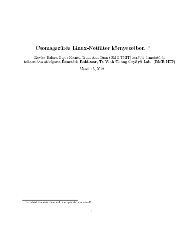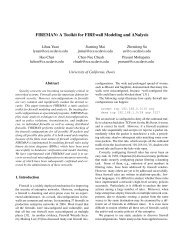Create successful ePaper yourself
Turn your PDF publications into a flip-book with our unique Google optimized e-Paper software.
2.3. Optimal trees in case of single member compromise<br />
Proof. B ∗ has the same elements as B has, therefore, the sum and the product of the elements of<br />
B ∗ are the same as that of B, and so if B satisfies the constraints of the optimization problem,<br />
then B ∗ does so too.<br />
Now, let us assume that B ∗ is obtained from B with the bubble sort algorithm. The basic step<br />
of this algorithm is to change two neighboring elements if they are not in the right order. Let us<br />
suppose that bi < bi+1, and thus, the algorithm changes the order of bi and bi+1. Then, using<br />
(2.2), we can express ∆R = R(B ∗ ) − R(B) as follows:<br />
∆R = 1<br />
N 2<br />
⎛<br />
⎝(bi+1 − 1) 2 b 2 i<br />
=<br />
=<br />
1<br />
N 2<br />
⎛<br />
⎝(bi − 1) 2 b 2 i+1<br />
∏ ℓ<br />
j=i+2 b2 j<br />
ℓ∏<br />
j=i+2<br />
ℓ∏<br />
j=i+2<br />
b 2 j + (bi − 1) 2<br />
b 2 j + (bi+1 − 1) 2<br />
ℓ∏<br />
j=i+2<br />
ℓ∏<br />
b 2 j<br />
j=i+2<br />
⎞<br />
⎠ −<br />
N 2<br />
(<br />
(bi+1 − 1) 2 b 2 i + (bi − 1) 2 − (bi − 1) 2 b 2 i+1 − (bi+1 − 1) 2)<br />
∏ℓ j=i+2 b2j N 2<br />
(<br />
(bi+1 − 1) 2 (b 2 i − 1) − (bi − 1) 2 (b 2 i+1 − 1) )<br />
= (bi − 1)(bi+1 − 1) ∏ℓ j=i+2 b2j N 2<br />
((bi+1 − 1)(bi + 1) − (bi − 1)(bi+1 + 1))<br />
Since bi ≥ 2 for all i, ∆R is non-negative if<br />
bi + 1<br />
bi − 1 ≥ bi+1 + 1<br />
bi+1 − 1<br />
But (2.5) must hold, since the function f(x) = x+1<br />
x−1 is a monotone decreasing function, and by<br />
assumption, bi < bi+1. This means, that when sorting the elements of B, we improve R(B) in<br />
every step, and thus, R(B∗ ) ≥ R(B) must hold. ⋄<br />
The following lemma provides a lower bound and an upper bound for the resistance to single<br />
member compromise:<br />
Lemma 2. Let B = (b1, b2, . . . bℓ) be a sorted branching factor vector (i.e., b1 ≥ b2 ≥ . . . ≥ bℓ).<br />
We can give the following lower and upper bounds on R(B):<br />
Proof. By definition<br />
(<br />
1 − 1<br />
b1<br />
) 2<br />
≤ R(B) ≤<br />
R = 1<br />
N 2<br />
⎛<br />
⎝1 + (bℓ − 1) 2 +<br />
=<br />
( b1 − 1<br />
b1<br />
) 2<br />
(<br />
1 − 1<br />
∑ℓ−1<br />
(bi − 1) 2<br />
i=1<br />
b1<br />
+ 1<br />
N 2<br />
⎛<br />
⎝1 + (bℓ − 1) 2 +<br />
) 2<br />
ℓ∏<br />
j=i+1<br />
b 2 j<br />
+ 4<br />
3b 2 1<br />
b 2 j<br />
⎞<br />
⎠<br />
⎞<br />
⎠<br />
∑ℓ−1<br />
(bi − 1) 2<br />
i=2<br />
ℓ∏<br />
j=i+1<br />
b 2 j<br />
⎞<br />
(2.5)<br />
(2.6)<br />
⎠ (2.7)<br />
where it is used that N = b1b2 . . . bℓ. The lower bound in the lemma 3 follows directly from (2.7).<br />
3<br />
( ) 2<br />
b1−1<br />
Note that we could also derive the slightly better lower bound of + b1<br />
1<br />
N 2 from (2.7), however, we do not<br />
need that in this chapter.<br />
15












